Fuel-Management Computers:
Shadin vs Electronics
International
![]()
Fuel-Management Computers:
|
|
by Stephan Wilkinson
|
This article appeared in the December 1995 Falco Builders Letter, and it originally appeared in The Aviation Consumer. |
The least accurate instruments in a light-aircraft cockpit often are the fuel gauges. Usually activated by a corklike float on the end of a thin metal rod that rises and falls through an arc in response to the fuel level in the tank, the rod "wipes" across a potentiometer that sends a signal to the needle on a cockpit gauge. It invariably seems that fuel gauges display increasingly less accurate readings as the fuel level falls, until-in a typical lightplane-it isn't a bit unusual to have the last five gallons per tank "unreadable."
So pilots have for a long time known that their real fuel gauge is the clock: If you have 60 gallons of fuel aboard and know that your engine burns 12 gallons per hour, obviously you can fly for five hours, right? Well, sort of. For even a Patek Philippe Texas Timex makes an approximate fuel gauge, since you need to factor in how much extra fuel you burned during the climb, how much you'll save during the descent, and what the density altitude is doing to your fuel-burn rate.
Much of that is irrelevant if you fly an airplane fat with fuel and make it a point to never, ever land without an hour's worth of gas left. I, however, own an airplane that carries only 40 gallons of fuel and has a 180-horsepower engine that-depending on altitude, power setting, care in leaning and phases of the moon-can burn anywhere between 8.5 and 10.5 gallons per hour, giving me a theoretical absolute duration of somewhere between 3+50 and 4+40.
Both of my airplane's fuel gauges have little red stripes near the "E" symbol, and they mean, "if the needle is down here, we're off duty. Silence means empty." To complicate matters further, I should drain one of the two tanks completely if I want to achieve maximum range, and this means 20 minutes of staring at the fuel-pressure gauge waiting for the first hint of a fluctuation. Fuel-injected engines can occasionally be difficult to restart in flight, so the buck and surge of the tank running dry is always a thrill.
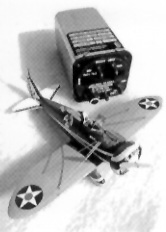
Shadin Microflo-L (Boeing P-26 model)
It also bears saying that running a tank dry in a twin can be even more disastrous. In one thoroughly recorded (on videotape) accident, a light twin with a high-time pilot at the controls underwent a fatal Vmc upset at low altitude when a tank ran dry and it took some 15 seconds for fuel pressure to be restored to the dead engine.
I sometimes fly 3.5-hour legs in my airplane, yet I have never enjoyed it. Particularly when I recently descended out of a nice tailwind and landed 50 miles short of my destination with both needles in the red and discovered to my dismay that I still had a dozen gallons aboard. (I felt a little better, however, when the FBO told me, "Yeah, some guy in a Navajo was also tryin' to stretch it there awhile ago, too. He landed about a quarter-mile short of the runway. Ran out of fuel.")
This is a long way of explaining why I've installed a modern, digital fuel-management system linked to the GPS receiver in my Falco and have discovered a superb instrument that is as vast a leap beyond conventional fuel gauges as loran and GPS are over the four-course range and airway beacons. As part of the process, I temporarily installed and compared two competitive light-aircraft fuel management systems that fit into 2.25-inch circular panel holes-The Shadin Microflo-L and the Electronics International FP-5L-and came up with some conclusions that surprised me.
A fuel-management system of the sort we're considering here is actually quite a simple setup. All of its wonderful functions-telling you how much fuel you'll have left when you reach your destination based on your current groundspeed, miles per gallon you're achieving at your current power setting and wind aloft, time to empty and so forth-are simply a result of the microprocessor magic to which we've all become accustomed. Like a Korean microwave oven, the unit could easily be loaded with far more functions than you'd ever want. Dollars per nautical mile? Percentage of fuel burned? Volume of fuel remaining in cubic inches? Fuel flow in pints per hour? Weight in ounces of fuel used? No problem.
Actually, that's not quite true: the 2.25-inch-diameter faces of both the Shadin Microflo-L and the Electronics International FP-5L are already crowded with switches, annunciators and readouts, and the fact that EI crams 11 separate functions into its tiny instrument is a laudable ergonomic achievement.
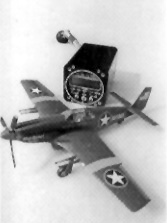
Electronics International FP-5L (North American
A-36 model, an early version of the P-51)
All such light-aircraft fuel-management systems get their basic input from a simple device called a fuel-flow transducer, and most of these transducers are made by Floscan. (Shadin now uses a different transducer for heavier equipment such as turbines, but its Miniflo and Microflo units intended for light singles and twins still use the Floscan.)
Twenty years ago, when I worked at an automotive magazine, we had as part of our performance-testing equipment a Floscan fuel-flow transducer identical to the one in my Falco today. We were then on the cutting edge of road-test technology; other buff books based their fuel-consumption calculations on the gallonage readings of the service-station fuel pump when they refueled a car after a test.
The Floscan transducer has been around for a long time, but it still serves its purpose. The unit is nothing more than a little paddlewheel through which the fuel flows, and the speed at which it spins is counted by a tiny photoelectric sensor. The more fuel flowing, the faster it spins; the faster it spins, the more "pulses"-revolutions-the lightbeam counts. The design shows extreme "reproducibility": If the vanes pulse 29,421 times per gallon today buzzing the sagebrush in Arizona, they'll pulse 29,421 times per gallon tomorrow at 18,000 feet over Alaska.
Fortunately for pilots and unfortunately for race-car teams, a transducer of this type requires steady-state flows for accuracy. Even a microprocessor has difficulty counting and averaging the wildly fluctuating fuel flows present in an automobile's fuel system, when the throttle goes from wide-open to closed under braking to gassing for up- and down-shifts. Which is why you still see Formula 1 and Indy cars running out of gas on the last lap despite sophisticated track-to-pit telemetry systems.
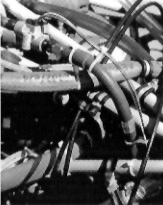
Fuel-flow transducer
However, it is possible for a well-designed lightplane unit to function based on the readings of a transducer in the fuel line even to a carburetor, where the flow is not as steady as a fuel-injection system's. (The indicator readout won't update as rapidly when throttle or mixture positions are varied, since the computer is averaging the readings, but the difference isn't great.) Electronics International's FP-5L offers numerous carbureted, STCed installations, though Shadin's Microflo-L has only some Lycomings.
Because there inevitably are tiny manufacturing variations, each fuel-flow transducer is calibrated individually at the factory by running a known amount of fuel through it, and the transducer is then assigned a "K factor"-K, unaccountably, for korrection. (Hey, whoever said these people can spell? Look what they do with the perfectly good word "bite.") The K factor is programmed into the computer/indicator, and the result should be nuts-on fuel-used accuracy.
The manufacturers-both Shadin and Electronics International-claim plus or minus two percent accuracy, which is the most the FAA will allow without demanding far more rigorous certification testing. Yet it's interesting how many owners of Shadin fuel-management systems complain of instrument inaccuracy ranging all the way up to 10-percent errors in fuel actually burned versus fuel-used figures computed by the Shadin.
Shadin claims that this problem only occurs when their units are hooked to an airplane's existing fuel-flow transducer rather than installed as a system with a new transducer supplied by them, but that's not the only reason for inaccuracy. Several factors can affect the operation of a transducer, ranging from electrical noise (which may require shielding of the transducer output wire) to installation variations, which requires resetting of the unit's K factor.
Ideally, a fuel-flow transducer should be mounted upright, dead-level and stock-still, which is the position it was in when initially flow-checked and calibrated. But when it's inside an engine compartment rather than on a flow bench, such factors as vibration, heat or even a trapped microscopic air bubble can change the K factor. The new flow rate will be absolutely consistent, but minutely different.
The Shadin installation manual says nothing about how to reset the K factor, so some owners aren't even aware this is a possibility. In order to reset it, you need to collect your actual-versus-indicated fuel-burn figures, call the factory tech-support line, let them figure a new K factor and tell you how to reprogram the unit (which requires getting at a couple of thumbnail switches inside the box). Shadin frankly doesn't want the liability of a pilot being able to screw around with the K-factor setting, particularly in flight. Electronics International's FP-5L manual is very clear on how to refigure and reprogram the K factor and indeed assumes that such calibration will be part of the initial dial-it-in process.
Shadin Microflo-L
Shadin, for better or worse, is the industry standard. The small
Minnesota company makes fuel-flow meters, totalizers and transducers;
engine trend monitors; and fuel/air data computers for a wide
variety of fixed-wing and helicopter piston- and turbine-engine
aircraft. (They're also in the process of type-certificating a
two-place, low-wing trainer based on an elderly European design.)
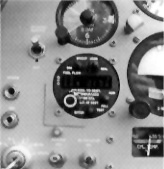
Recently, Shadin has had the lightplane fuel-management system market pretty much to themselves. At one time, Alcor, Hoskins and Silver also made simple fuel-management systems, but all are out of production. Hoskins continues to produce a fuel totalizer, the FT-101A, which displays either the amount of fuel used or the current fuel flow-a small fraction of the functions that the Shadin and EI units offer-but it is certificated only for Mooneys.
Shadin offers two versions of its basic system: the rectangular, 7.5-inch-deep Miniflo and the round, 4.25-inch-deep Microflo, which fits into a standard 2.25-inch small-instrument hole. Both provide fuel-used/fuel-remaining/fuel-flow data or, for about $200 more, can be interfaced as -L models with a variety of lorans and GPS receivers to also provide real-time endurance and nmpg functions. My choice was the Microflo-L, since installation simply meant substituting it for a G-meter that I never used anyway. (Large avionics houses sell the Microflo-L and transducer for about $1,500, $1,300 without loran/GPS functions. Installation and hoses are extra, of course.)
Some pilots will argue that the loran/GPS interface is a waste of money, for all you're doing is electronically melding two functions you already get for free: The plain Microflo will tell you time to empty, and your rnav unit will tell you time to destination. The $200 buys you an interface that does the arithmetic-subtracts one from the other-for you. (That isn't entirely true in the case of the Microflo-L, which also offers a miles-per-gallon readout.)
Some also criticize the fact that though the readout is marked "fuel to destination," it may not be your destination at all; the unit is computing based on whatever waypoint, beacon, fix or airport you happen to have programmed into the rnav. If that's a fault, it exists equally in both the Shadin and EI units.
Behind the panel, the Microflo-L is in a standard stamped-aluminum instrument can 2.25 inches square. The face of the instrument is silk-screened in ordinary instrument-legend white-on-black, and has a relatively haphazard scattering of four microtoggle switches and one clunky four-position rotary wafer-switch knob (which seems a bit out of place on a box this expensive). The readout can be manually dimmed for night flight, but the unit will not interface with your aircraft's panel-dimming system.
Installation is relatively simple. Three wires come through the firewall from the fuel-flow transducer, two go to ship's power and ground, and one more brings serial data from the loran or GPS. All terminate at a standard nine-socket female computer microconnector that mates with pins on the back of the indicator can. For do-it-yourself installation-homebuilders or those of you who can get somebody to sign it off-the most you might need to do is have an avionics technician install the shielded wire from the radio rack; everything else is about as complex as wiring a dimmer into your dining room light switch.
In the case of my Falco, however, which carries a Northstar GPS 600, the Shadin installation also required intallation of an RS-232/422 serial-data converter box, roughly the size of a pack of cigarettes and costing an additional $175. (The Electronics International FP-5L already contains the interface circuitry.) Though only Northstar-equipped panels require the interface unit, don't assume compatability with your loran or GPS unit will be a simple plug-in job. It might be, but it might not, judging by the experience of owners queried on the CompuServe Avsig forum.
Also in my case-which could well have had more than a little to do with the fact that I'm not an avionics technican-installation of both the Shadin and EI units required several consultations with the factories before GPS data came through, even though achieving the basic transducer-generated figures was a piece of cake.
Both the Shadin and EI units call for wiring that at first glance seems a bit baffling to those of us only superficially familiar with digital "serial data." If you're computer-wise, you'll figure it out quickly, but the bottom line is that some of the wiring shown is irrelevant: it's only there to provide the capability for your loran/GPS unit to redundantly display the same fuel-to-destination and fuel-reserve information your fuel computer is already showing (assuming your loran or GPS has this capability). All you really need to hook up is the nav unit's signal-input wire and, if you're fussy, its shield.
Installing the transducer in the fuel line is equally simple, though you'll need to buy (or make up) a new line to accommodate the transducer, which takes up the equivalent of about two inches of hose. Shadin supplies the 800 number of Herber Aircraft Co., which will make up the proper Aeroquip replacement hoses and firesleeving to fit each STC, or will do it based on your measurements for an experimental installation.
Shadin uses a five-by-seven-dot matrix of tiny LEDs for its display, a presentation they chose largely in order to provide better visual continuity with modern avionics-particularly the newer GPSes. In fact, they offer the option of either yellow or red LEDs if you're into serious panel styling and are offended by a hodgepodge of colors and readouts.
One Shadin advantage that is immediately apparent is that the display presents two readouts at all times: gph at the left, and at the right, whatever optional readout is selected (fuel to destination, endurance time, etc.). The competing EI FP-5L unit displays only the single selected function.
Another is that all fuel readouts-fuel used, fuel remaining, fuel to and at destination-are in gallons and tenths, whereas the Electronics International unit displays only gallons. Individual tenths might not matter, and indeed Electronics International argues that normal variations in topping-off techniques invalidate any attempt at such precision, but frankly, I find the preciseness reassuring even if it's of superficial importance.
The Microflo-L also has a rotary-switch position marked "nmpg"-nautical miles per gallon. Using groundspeed data from the loran or gps, it calculates your efficiency in terms of fuel burn (though not necessarily speed) depending on various altitudes and wind components. If you're like the neurosurgeon who jots down the mpg of his 12-cylinder BMW 750i at every gas station, you'll love it. If you're like many pilots, you'll two-block the throttle and choose your altitude based purely on groundspeed.
Electronics International FP-5L
The first thing you'll notice about the FP-5L is its apparently
excellent-albeit admittedly external-quality and ergonomics. Unlike
the Shadin unit, the behind-the-panel enclosure is an anodized,
extruded-aluminum box, a miniature version of the sort you might
see enclosing top-end hi-fi equipment. (The disadvantage is that
it's a full 2.5 inches square rather than the Shadin's 2.25 inches,
making the clearance between the adjacent instrument-in the case
of my panel-so tight that I had to reroute one existing wire,
small as it was.)
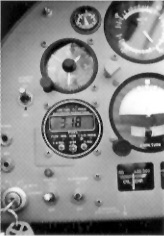
The face of the FP-5L has sharp, high-quality embossed legends and markings, and the layout is, at least to my eye, more appealing and logical than the Shadin's: a single left-or-right toggle switch selects functions in linear fashion, and the selected functions are indicated by a row of five green indicator lights. Two tiny pushbuttons are used both for programming (the once-in-awhile parameter programming as well as the constant fuel-added programming) and for selection of the loran/GPS functions, which consist of "fuel to destination" and "fuel reserve at destination." As is true of the Shadin, the unit considers the "destination" to be whatever fix happens to be selected on the loran/GPS at that moment.
Many pilots seem to consider the EI's faceplate to be less professional in appearance than the Shadin's. To some, it seems an item more appropriate for a hot rod's dashboard than an aircraft instrument panel. "Looks like one of those fifty-cent stick-on clocks," said one, homing in on what to him was the cheap-appearing liquid-crystal display. Depends where you're coming from, I guess. A dot-matrix display like the Shadin unit's always puts me in mind of cheap home-computer printer output. Neither opinion is at all relevant, for both displays seem quite legible even in bright sunlight, though the Shadin's is harder to see through dark sunglasses. (The FP-5L's is backlit to increase daytime visibility.) EI likes the LCD readout because there are no filaments to fail-and, I'm sure, because it's cheap.
Electronics International claims that one of the FP-5L's strengths is the rapidity with which it updates its display. Move the mixture control, and you get a near-instant readout of the fuel flow in gph, rather than jiggling the mixture, waiting for the display to catch up, and then having to correct back to the flow number you wanted. (Once you've installed and become familar with one of these units, you'll find yourself straightaway setting mixture according to fuel flow-just as you would on a turbine aircraft-rather than referring to an EGT indicator. You'll learn that what you want is 10.1 gph at full throttle/2,400 rpm at your normal cruise altitude rather than going through the whole lean/peak/enrich/stabilize sequence.)
Unfortunately, I was unable to confirm this in the Falco because I'd installed the FP-5L so that it was reading fuel-flow information from the transducer I'd already permanantly installed for the Shadin Microflo-L unit. It was a transducer sized for a slower-acting computer, so the FP-5L had to be reprogrammed for a slower update rate of about once per second rather than the optimal 2.5 times per second.
However, this demonstrated another FP-5L characteristic: the manner in which it can be programmed for various criteria that you personally preselect, one of which is the update rate. You like your readouts in liters, Imperial gallons or pounds rather than plain old gallons, for example? Done and done: tell the unit what you wish, change it from day to day or according to the party in power at the moment, and that's the readout you'll get. The Shadin Microflo will read in any of a variety of modes, including pph for either jet fuel or avgas, but the selected criterion is factory preset, and you'll have to call the factory technical-support line to find out how to change it. (It's not hard, but nor is it spelled out in the ops manual. Shadin would rather that you didn't mess with the unit, particularly via the front panel in flight.)
There are also two programmable red annunciator lights, one for low fuel and the other for fuel pressure. The "low fuel" light can be programmed to blink first when you reach a fuel level that you have determined is the lowest you want to go before considering landing at the next reasonable opportunity-say an hour's fuel if you're cautious-or simply when you want to switch tanks. (Pressing any button or moving the step-switch cancels that blinking.)
You can also program that light to blink again at a For-God's-sake-put-'er-down point. This time, it will stop winking when you manipulate any button or switch, but the annunciator light will then continue to glow steady red. Program in your own limit number according to your bravery.
If the word "programming" brings to mind the horror of resetting the blinking "12:00...12:00...12:00" on your VCR, have no fear. Setting and resetting the FP-5L consists of a simple sequence of switch- and button-pushes that are done with the engine off and the aircraft powered up, and it's simple enough that you could change the parameters from flight to flight if you wished (setting the low-fuel warning at 30 minutes for VFR and 45 for IFR, for example).
The second red annunciator light covers high and low fuel-pressure warnings, and can either be programmed for whatever limits you wish-say those in your engine-operating manual. Or, if it bothers you to have a red light come on at idle or during full-throttle takeoffs, the light can be totally disabled (though the fuel-pressure psi reading will still be indicated in the readout window). Still, a high-pressure light can warn of a clogged injector or other ailments. And if you set the low-pressure light to come on at a pressure high enough that it will detect the first fluctuation of a tank running dry, it can be a boon for people like me, who routinely empty a tank.
The fuel-pressure functions of the FP-5L are an option, and they require the installation of a four-wire pressure transducer, in addition to the normal fuel-flow transducer. This needs to be mounted on the end of an extension hose teed off the fuel line somewhere upstream of the fuel-flow transducer.
Why not just disconnect the existing fuel-pressure line leading to your cockpit fuel-pressure instrumentation and instead route it to the EI pressure transducer-which in fact is what I did for my temporary test, since the Falco is experimental? Because the EI unit is STCed only as a secondary source of fuel-pressure information and must be placarded, "Refer to original fuel flow/pressure instrumentation for primary information." (Shadin's Microflo can, in certain cases, replace original-equipment fuel-flow instrumentation, which is nice if you need that instrument hole for some other purpose.) Also, reading fuel pressure at the injector spider doesn't provide the fastest possible response rate, even if experimental status did provide me with this option.
Though the FP-5L provides fuel flow and fuel pressure information to the tenth of a gallon or psi (and time to empty in hours and minutes), fuel used/remaining is shown only in whole gallons. As noted earlier, I prefer to see tenths, though it can certainly be argued that if you're so low on fuel that pints matter, you're in excrement too deep for any instrument to help. It does require, however, that in order to reprogram the unit with a new K factor-which can be done in a matter of seconds, after you've done the arithmetic to show the difference between fuel actually burned and fuel the FP-5L as originally installed says you've burned-you need to flow perhaps 150 gallons through the instrument before making the correction. Since you can only adjust in increments of whole gallons, you need to have burned enough fuel that a few tenths one way or the other are immaterial.
One complaint, which may have something to do with the unit's gallonage coarseness: at times, readings sampled in flight will be off by a gallon here or there. For example, "fuel remaining" will show as 29 gallons, yet at the same time, the GPS-generated "fuel to destination" and "fuel reserve at destination" figures will show as 3 gallons and 27 gallons, obviously totaling 30 remaining rather than 29.
Another EI characteristic to be aware of: the loran/gps-generated data (fuel to destination and fuel reserve at destination) are available only as momentary readings, displayed for whatever length of time you hold in the relevant pushbutton. Whether this is a limitation depends on whether you happen to prefer that such a reading be on screen for extended periods of time (as is possible on the Shadin unit).
What is noteworthy, however, is that all this comes at two-thirds the price of the Shadin Microflo-L-about $1,000 complete, including the optional fuel-pressure transducer, from avionics discounters. (Subtract about $250 if you're willing to forego the GPS link, making the straight FP-5 quite a bargain.) Unlike Shadin, however, EI leaves it up to you to find a supplier for the proper-length hoses.
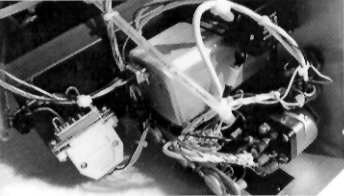
Bottom Line?
When I began this experiment, I bought from Shadin a Microflo-L
and borrowed from Electronics International an FP-5L, figuring
that the Shadin was the industry standard and the one I'd want
to end up owning. Also, several friends owned Shadin Miniflos
(the somewhat larger rectangular-head version) and were quite
happy with them. By the end of the test, I realized the choice
was not so simple, though I'm happy with the dual readouts and
greater apparent preciseness of the Microflo-L. Here's the scorecard:
compactness: Shadin slightly narrower, Electronics International
slightly shorter; superficial quality and graphics: EI, in my
opinion; TSOed: Shadin; STCs: EI (includes more carbureted engines);
switchology and ergonomics: EI; number of functions: EI; visual
warning functions: EI; miles-per-gallon information: Shadin; fuel-pressure
information: EI; amount of information displayed: Shadin; display
precision: Shadin (tenths of a gallon); display clarity in daylight:
EI; installation manual clarity and completeness: EI; factory
support and installation advice: my experience with both was outstanding,
but several Consumer readers have complained that Shadin has been
unresponsive to GPS-interface problems; update rate: EI, at least
according to its own claims; ease of programming: EI; price: EI.
Who wins the contest frankly depends on the weight you give
to various criteria-price, number of functions, TSOs, type and
variety of readouts, etc. But however you look at it, a modern,
compact fuel-management system is one of the most effective and
economical additions you can make to your panel. If you're flying
a highly stressed, turbocharged time bomb of an engine, you might
prefer to devote the money and panel space to an engine analyzer/monitor
of some sort. Frankly, however, I'm happier to be flying with
a plain old EGT and a good "gas gauge" for the first
time in my lightplane life.
|
|